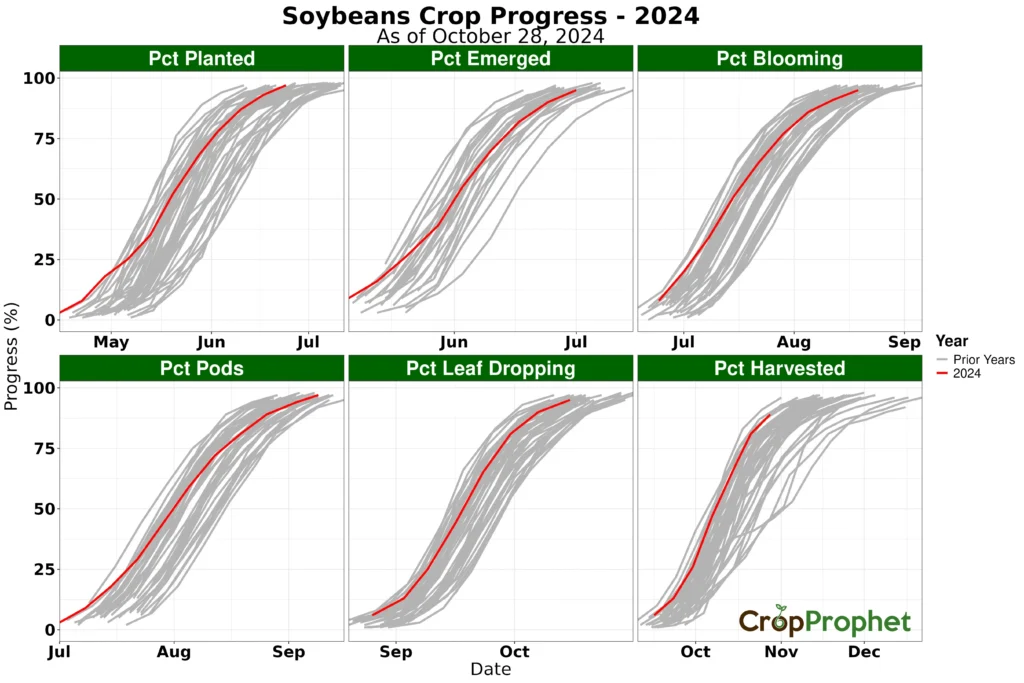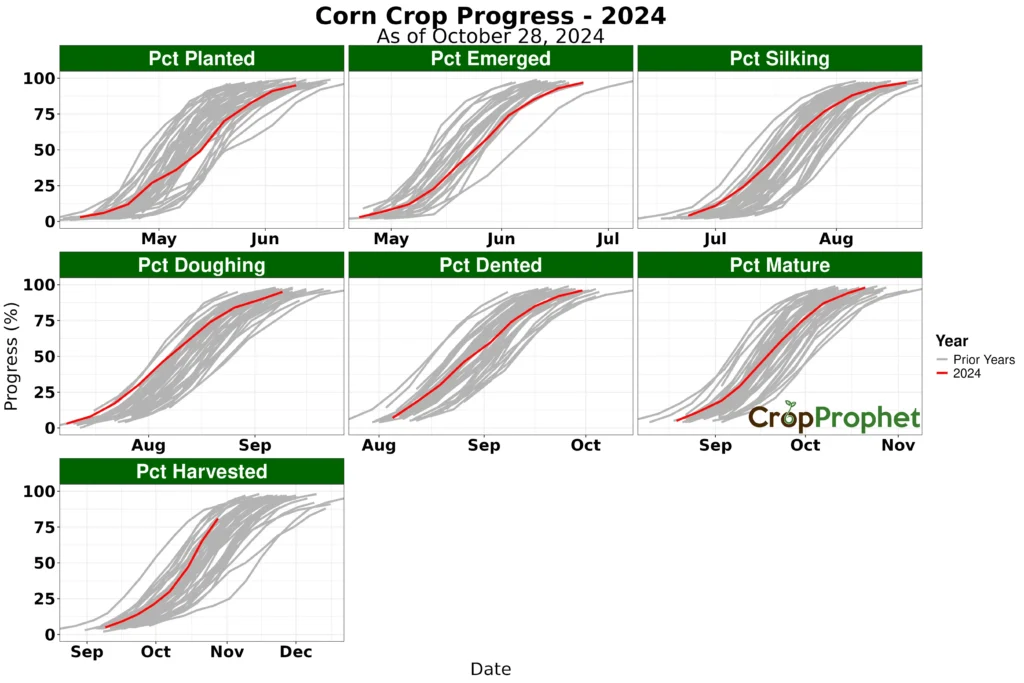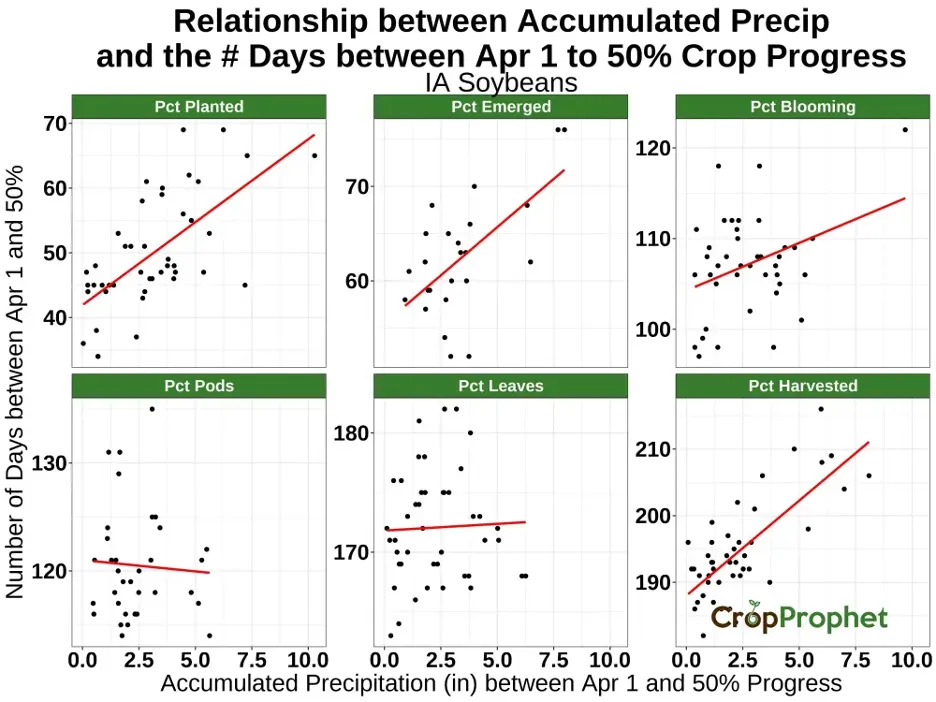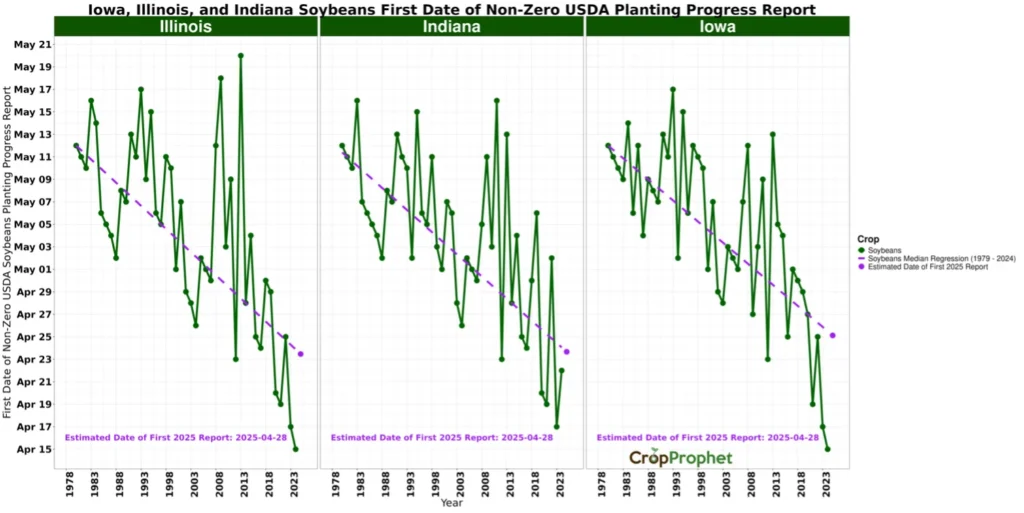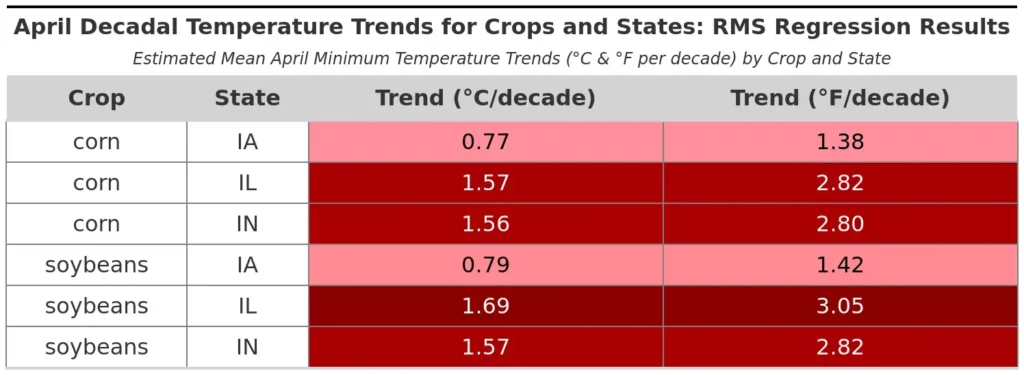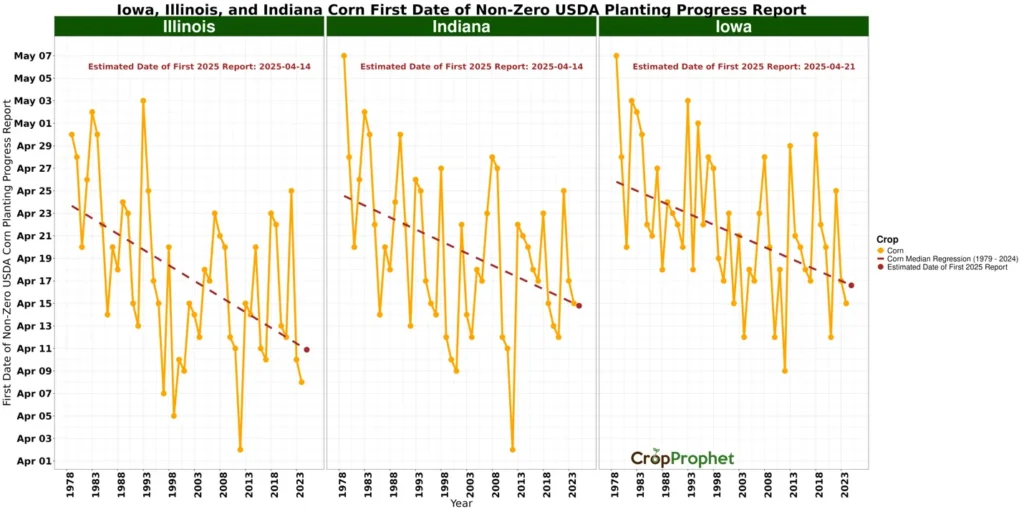USDA Crop Progress Reports: Earlier Corn and Soybean Planting
Introduction
For U.S. soybean farmers, economic pressure and the pursuit of higher yields push planting dates earlier each year. With tight margins and volatile grain markets, maximizing soybean production is essential for profitability. Research shows that earlier planting increases yield potential by extending the growing season, allowing plants to take full advantage of available sunlight and reach key developmental stages before the peak summer heat.
But weather remains a major factor in this shift. Cool soil temperatures in early spring can slow germination and increase the risk of seedling diseases, while late spring frosts threaten emerging plants. Farmers must also consider the timing of spring rainfall—too much moisture can delay planting, while dry conditions may hinder early-season growth. Despite these risks, many producers are willing to adapt their management practices—using seed treatments, adjusting planting depths, and selecting early-maturing varieties—to take advantage of the yield benefits that early planting can provide.
The USDA releases crop progress reports every Monday during the growing season, offering critical insights into planting and crop development. These reports provide weekly updates on major U.S. crops’ planting, emergence, and growth progress, particularly corn and soybeans. In recent years, a major trend has emerged—earlier planting dates. We examine this trend below.
2024 USDA Crop Progress Reports for Corn and Soybeans
The 2024 USDA crop progress data indicates that planting has begun earlier than usual, continuing a shift observed over the last several decades. While both corn and soybeans are being planted sooner, soybeans have experienced an especially accelerated shift due to climate trends, technological advancements, and agronomic strategies. This post analyzes the historical and recent trends in U.S. crop planting dates, focusing on Iowa, Illinois, and Indiana—key agricultural states.
The 2024 crop progress for soybeans and corn is illustrated in 1(a) and 1(b), providing a comparison of planting progress against previous years.
(a)
(b)
Figure 1. (a) USDA United States crop progress for soybeans in 2024. (b) USDA United States crop progress for corn in 2024.
Corn and Soybean Planting Trends: A Long-Term Shift
US Corn planting dates have steadily moved earlier in the season, driven by multiple factors. A warming climate has allowed farmers to enter fields sooner, reducing the risks of late spring frost. Improved seed genetics provide greater resilience, while advances in precision agriculture enable farmers to optimize planting timing. These developments have ensured that corn planting begins earlier than in past decades.
However, soybeans are undergoing an even more dramatic transformation. While corn farmers have steadily pushed planting forward, the acceleration of soybean planting has outpaced that of corn in recent years. The shift is driven by early-planted soybeans consistently producing higher yields. Farmers are now prioritizing soybean fields alongside corn when conditions allow.
Impact of Precipitation on Planting Progress
Weather conditions help to determine how quickly farmers plant their crops. In years with above-average spring precipitation, fieldwork is delayed, leading to a slower pace of planting progress.
In Iowa, data shows that as April precipitation increases, the number of days needed to reach the 50% planted threshold also increases. This impact is particularly pronounced in soybeans, which are more sensitive to early-season soil moisture conditions (Figure 2).
Figure 2. Relationship between accumulated precipitation and the number of days from April 1st to 50% soybean planting progress in Iowa.
Historical Crop Planting Trends: The First USDA Planting Progress Report
Since the late 1970s, the first non-zero USDA planting progress reports for both corn and soybeans have shifted earlier in the season. However, the shift is far more evident in soybeans, especially in the key production states of Iowa, Illinois, and Indiana.
The advancement of the first reported soybean planting progress in these states is highlighted in Figure 3 which shows how the timing of planting progress has shifted over time.
Figure 3. Iowa, Illinois, and Indiana first date of non-zero USDA soybean planting progress reports by year.
Corn planting has historically set the pace, but soybean planting has caught up. Farmers now plant soybeans as soon as conditions allow, taking advantage of longer growing seasons and more resilient seed varieties. Agronomic research underscores the yield benefits of early planting. Early-planted soybeans capture more sunlight during the growing season, increasing pod set and yield potential (Salmeron et al., 2022).
Soybean Planting: A Data-Driven Analysis
Soybean planting dates in Illinois, Indiana, and Iowa have sifted earlier in the year over the past two decades. USDA records from 1979 to the present confirm that the first reported planting date continues to move earlier, reflecting improved farming efficiency and a warming climate.
A root mean square-based regression model projects that the 2025 USDA planting progress report for soybeans will be released even earlier, reinforcing this long-term trend.
Supporting this forecast, temperature data sourced from the Point-in-Time Forecast API shows a clear warming signal in April temperatures across the Midwest:
- Iowa: +1.38°F per decade
- Illinois: +2.82°F per decade
- Indiana: +2.80°F per decade
These findings, shown in Table 1, strongly suggest that warming trends are increasing planting readiness for soybeans, allowing farmers to take advantage of earlier planting windows with greater confidence.
Table 1. Corn and soybean root mean square regression results for April mean daily minimum temperature trends.
Corn Planting Progress: Following a Similar Trend
Corn planting progress has followed a similar pattern, though at a slower rate. Since 1978, USDA reports have tracked planting progress in Illinois, Indiana, and Iowa, showing a clear movement toward earlier start dates. However, the acceleration in corn planting has been less pronounced compared to soybeans.
The advancement of the first non-zero USDA planting progress reports for corn over time is shown in Figure 4.
Figure 4. Iowa, Illinois, and Indiana first date of non-zero USDA corn planting progress reports by year.
A root mean square regression model predicts that the 2025 USDA planting progress report for corn will arrive earlier than historical averages. However, it will likely not match the rapid acceleration observed in soybeans.
Discussion: The Growing Importance of Early Soybean Planting
The acceleration of soybean planting dates has been the most significant transformation in U.S. crop planting strategies over the last five years.
Economic incentives are a key factor in this shift. Early planting allows farmers to extend the growing season, increasing the likelihood of higher yields and maximizing profit potential. Grain markets often reward early-season production with higher basis levels and premium pricing opportunities. Additionally, early planting helps farmers manage operational risks by reducing bottlenecks during peak planting periods, ensuring that corn and soybean acres are established within optimal windows. Studies indicate that planting earlier extends the vegetative phase, resulting in more main stem nodes, which are critical for maximizing soybean yield.
Conclusion
Soybean planting has accelerated rapidly, outpacing corn with increasingly earlier start dates. This shift reflects a broader transformation in U.S. agriculture, where farmers leverage warming temperatures, cold-tolerant seed varieties, precision planting technology, and market-driven incentives. As these factors continue shaping planting decisions, soybeans have emerged as the crop most responsive to climate adaptation, technological advancements, and shifting agronomic strategies.
Looking ahead to 2025, all signs indicate that the first USDA soybean planting progress report will arrive even earlier than in past years, further solidifying early soybean planting as the new norm. While corn planting will likely continue shifting forward, soybeans will remain at the forefront of this transformation. As USDA crop progress reports reflect these trends, early-season monitoring will be essential for understanding and adapting to evolving planting windows.
References
Salmeron, M., Purcell, L. C., Gbur, E. E., Chen, P., & Shannon, G. (2022). Early planting benefits and yield potential of soybean in the United States. Agricultural Systems, 198, 103373. https://www.sciencedirect.com/science/article/abs/pii/S0924271622000314.
